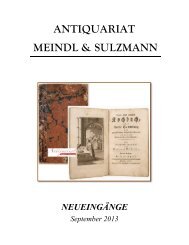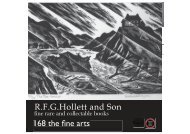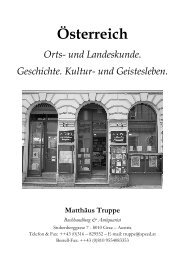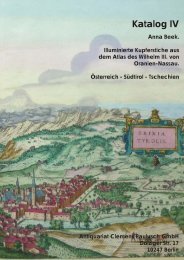Japanese Prints
Japanese Prints
Japanese Prints
Create successful ePaper yourself
Turn your PDF publications into a flip-book with our unique Google optimized e-Paper software.
74<br />
Fern<br />
represents long life, and happiness in marriage. Its leaves are white<br />
on one side and black on the other, which stands for honesty and<br />
sincerity.<br />
Firefly<br />
fireflies symbolise the summer and they have been a metaphor for<br />
passionate love in poetry since the 8th century. Their eerie lights are<br />
also thought to be the altered form of the souls of soldiers who have<br />
died in war.<br />
Four Noble Flowers<br />
The chrysanthemum, the plum blossom, the orchid, and bamboo.<br />
Frog<br />
The frog is thought of as good luck for travellers. Images or charms<br />
in the shape of frogs were worn during long voyages to assure<br />
safety, particularly across water. The <strong>Japanese</strong> word for frog is<br />
“kaeru”, which sounds like the word “return.” Travellers carry a<br />
small frog amulet with the intent of returning safely home.<br />
Gardenia<br />
This flower represents happiness, elegance, and sophistication.<br />
Gladioli<br />
Gladioli represent preparedness, strength, splendid beauty and love<br />
at first sight.<br />
Goose<br />
The geese on their migration journey during autumn, when the<br />
weather begins to turn cold and plants wither for the winter. This<br />
suggests the Buddhist idea that everything in life is impermanent,<br />
and that all plants and animals are born, reproduce, die, and decay.<br />
They are also a chinese emblem of caution. Wild geese normally<br />
fly in a straight line. When the line is broken it suggests that there<br />
are unusual circumstances beneath them.<br />
Heron<br />
The heron has the habit of standing perfectly still and is therefore<br />
emblematic of Buddhist meditation. Often depicted among lotus<br />
leaves, standing on one leg (it never stirs up the mud), it symbolises<br />
Buddhist purity. Associated with the black crow, it suggests day and<br />
night, good and evil.<br />
Hibiscus<br />
represents continually rejuvenating youth, beauty and bravery.<br />
Hydrangea<br />
The hydrangea is a symbol expressing love, gratitude, and enlightenment.<br />
It is said that the observer can easily get lost in its abundance of beautiful<br />
petals, and thus getting lost in higher thought and reaching enlightenment.<br />
due to its versatility, and beauty, the hydrangea makes an excellent thank<br />
you gift to an unsung hero in our lives.<br />
Iris<br />
The collection of 10th century lyrical prose and poems, Tales of ise,<br />
recounts how a heartsick lover composed poetry to a wild iris in<br />
place of his lost love. Since then the iris has come to symbolise<br />
romance and heroism. It is also a potent symbol against evil spirits.<br />
Kozuchi (miracle mallet)<br />
The Kozuchi is a legendary <strong>Japanese</strong> hammer, and translates as<br />
“Small Magic Hammer” or “Miracle Mallet”. The mallet is very<br />
small, and swinging it grants its holder’s wishes. It is a symbol of<br />
good fortune.<br />
Kuniyoshi, Utagawa (c.1797 - April 14, 1861)<br />
Together with Hokusai and Hiroshige, Utagawa Kuniyoshi is known<br />
as one of the greatest <strong>Japanese</strong> printmakers and a master of imaginative<br />
design, dominating the <strong>Japanese</strong> print world of the 19th century. The<br />
son of a silk-dyer, Kuniyoshi was initially involved in his father's<br />
business as a pattern designer, it is said that as a child he was impressed<br />
by ukiy_-e warrior print and by pictures of artisans and commoners<br />
depicted in craftsmen manuals, such as those seen in his later works.<br />
His early works include a series of prints of kabuki actors and warriors,<br />
as well as a series of pictures of beautiful women, known as bijinga,<br />
in which he experimented with large textile patterns and light-andshadow<br />
effects found in Western art. In the 1820s he was finally<br />
accepted into the important ukiy_-e circle, with his first major<br />
commission, ‘One Hundred and Eight Heroes of the popular Suikoden’<br />
based on the popular chinese tale, the Shuihu zhuan. Kuniyoshi<br />
continued to draw many of his subjects from traditional tales of war,<br />
but with an added stress on dreams, ghostly apparitions, omens and<br />
superhuman feats, themes which satisfied the public’s interest in the<br />
ghoulish, exciting and bizarre. In the 1840s Kuniyoshi’s critical view<br />
of the shogunate won him further favour with a politically dissatisfied<br />
public through a series of caricature prints in which disguised actors<br />
and courtesans were portrayed, at a time when illustrations of<br />
courtesans and actors in Ukiy_-e were officially banned. He also<br />
produced more naturalistic works of animals, birds and fish, parodies<br />
of traditional <strong>Japanese</strong> and chinese painting, and a series of landscape<br />
views incorporating Western shading, perspective and pigments. Later,<br />
he experimented radically with composition, magnifying visual<br />
elements in the image for a dramatic, exaggerated and quite modern<br />
effect, still seen today in <strong>Japanese</strong> manga illustrations. The fantastic<br />
and dynamic prints by Kuniyoshi were brought to the fore in a recent<br />
exhibition at the royal Academy and Sotheran’s is very fortunate to<br />
have several of his prints in this exhibition.

















